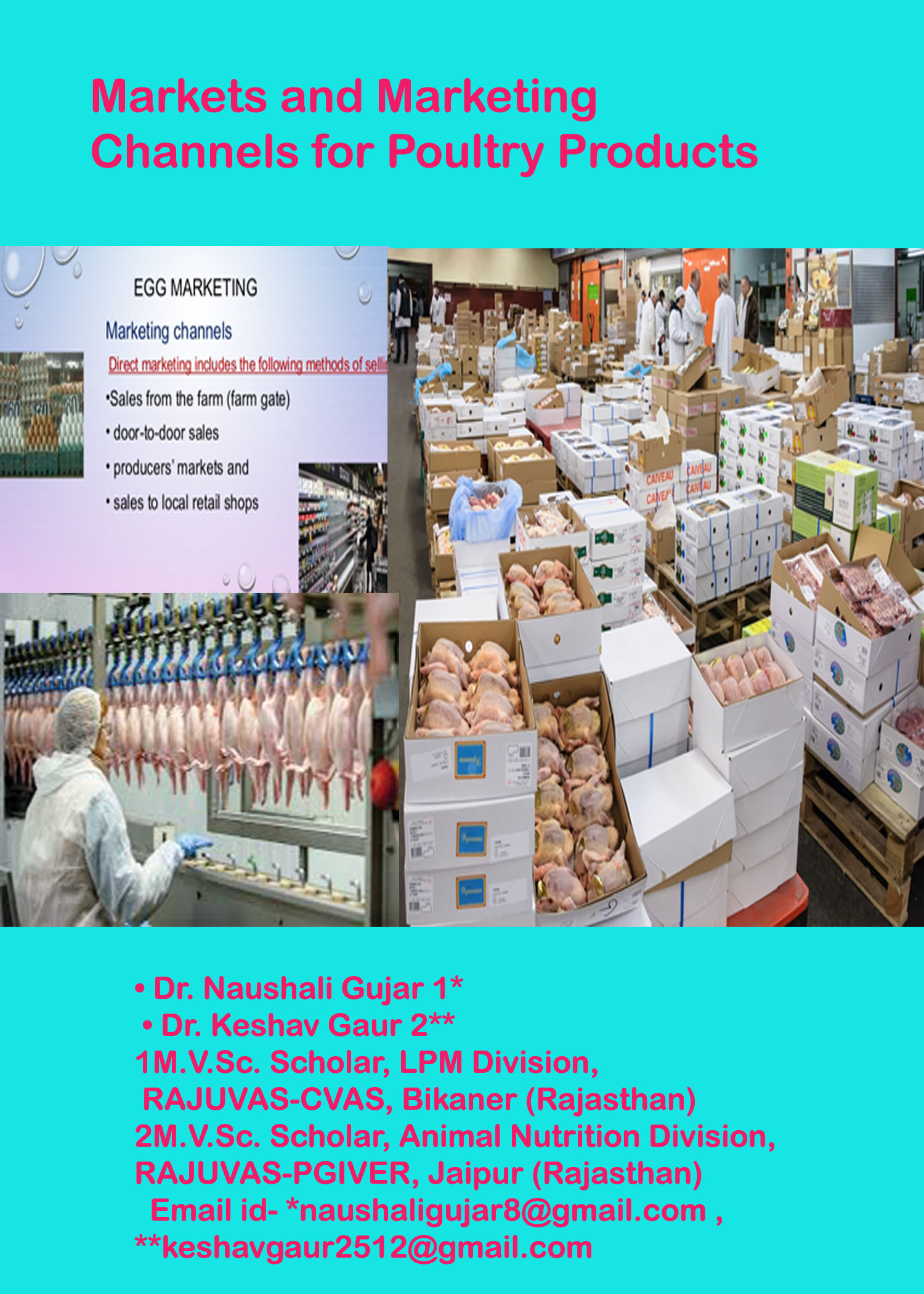Markets and Marketing Channels for Poultry Products
- Dr. Naushali Gujar 1* • Dr. Keshav Gaur 2**
1M.V.Sc. Scholar, LPM Division, RAJUVAS-CVAS, Bikaner (Rajasthan)
2M.V.Sc. Scholar, Animal Nutrition Division, RAJUVAS-PGIVER, Jaipur (Rajasthan)
Email id– *naushaligujar8@gmail.com , **keshavgaur2512@gmail.com
Introduction:
The word ‘market’ is derived from a latin word ‘mercatus’ meaning trade or merchandise or a place; where business is conducted. The most important aspects of any business is the marketing of the products. Marketing consists of the performance of business activities that directs flow of goods and services from the producer to the ultimate consumers or end users. Marketing tries to find out the right type of production that the farm must undertake, the right place where it is to be made available, the right time the products are to be made available to the consumers and the right channel through which they are to brought to the notice of the consumers. Marketing channels are the path; traced in the direct or indirect transfer of title of a products, as it moves from a producer to the ultimate consumers. A channel includes both the producers and the consumers as well as all middlemens.
Marketing is one of the weakest links in the rural poultry developments programmes, whereas it is the strongest link in the cities and metros. Presently, the market for poultry products is concentrated in the peri-urban and urban areas. Even in the 21th century; the overall impressions of the market is that, it is not well organized and there is exploitation by brokers or middleman. Thereby reducing the profit margins for the farmers; who are under threat by weather, price fluctuations and productivity.
Markets for Eggs and Meat :
In India; agencies like National Egg Coordination Committee (NECC) established in 1982 and All India Broiler Farmers Marketing Cooperative Limited (BROMARK) are declaring prices for eggs and broilers based on the market dynamics and has participation of farmers, which helps to solving the problem of middlemen to some extent.
Broiler Coordination Committee (BCC) also declares sale price of live broilers from time to time. Infrastructure like cold storage and retail outlets will help stabilize the market in term of price fluctuations. On the basis of area and space, markets can be classified as local markets, national markets and international markets. Normally, the products are sold through direct or indirect or integrated or cooperative method.
- Eggs market – Like any other food commodities, various types of markets deal with the sale of eggs. The market size may be small to big. In district or sub-division level, wholesale markets (Mandi) are available where one can purchase eggs in bulk quantities. The eggs are also sold out through daily hawkers, egg thelas, egg-trollies, egg-kiosk, groceries-shops, hotels, restaurants and shopping malls. The table eggs are generally marketed as they are produced without cleaning, grading, chilling and only about 5% of the total eggs produced are utilized as an egg-based products by food and non-food industries. Most small flock producers, base their price on the current store prices in the area they live. However, many organized producers market their eggs as a specialty items and receive premium prices. Brown eggs and organic eggs often will bring higher prices.
- Sale of broiler meat (chicken) – The wholesome markets for the live birds are very few in number, but one can find such markets in big cities and from there, the small shop keepers of neighbouring areas get live birds through agents or brokers or middlemen. The live birds are sold by count in mandi, but on live or dressed body weight basis by the retail poultry meat shopkeeper. Of the dressed chickens, approximately 75% are sold as hot dressed, chilled or frozen whole carcass and rest 25% as raw or marinated cut-up portions, de-boned meat, fillets and further processed value added products such as burgers, kababs, nuggets, patties, samosas, sausages and soups. Even the big poultry producing companies of the country sells 40% live broilers, 55% chilled or frozen chickens; hardly 5% only is sold as a value added products through their retail outlets. Among the consumers, about 30% of the total population comes from urban pocket and 70% belong to rural area. In most of the places, a common market of small and big size for eggs and poultry meat is in operation. Now-a-days, many stockiest who trade poultry and its product throughout the country are available.
Marketing Channels for Eggs and Meat :
In India, following marketing channels are available to sale eggs and poultry-
- From farm to consumers (Direct)
- The raw finished products rolls from one hand to another and then finally reaches to the end user. This means that between producer to consumer; the brokers/middlemen, bulk buyers/institutional buyers/stockiest/whole sellers and retailers play a vital role in marketing of raw or finished products. i.e.
Producer Broker/Middlemen Wholesale Retailers Consumers
- Small or big shops, retail outlets, canteens, hotels, restaurants, refrigerated, display cabinats and fast food shops are also involved as different marketing channels.
- The NECC established in 1982 has about more than 30000 poultry farmers as members and carries out different programme such as market intervention, price support operations, egg promotion campaigns, consumer education, market research, rural market development and liaison with the government on vital issues concerning the industry to declare egg price.
- Similarly; just like NECC, BROMARK and BCC are also engaged in price fixation and marketing of broilers in our country.
- The quality assurance is very important in marketing channels. The AGMARK is involved in grading and maintenance of quality of eggs and meat products.


